Class 8 English Honeydew Chapter 3 Question Answers - Glimpses of the Past
| Table of contents |

|
| Comprehension Check (Page 45) |

|
| Working with the Text (Page 45) |

|
| Working with Language (Page 45) |

|
| Speaking and Writing (Page 46) |

|
Comprehension Check (Page 45)
Q1. Look at picture 1 and recall the opening lines of the original song in Hindi. Who is the singer? Who else do you see in this picture?

Ans. The opening lines of the Hindi song are Aye Mere Waten Ke Logon, Tum Khub Lago Nara: Ye Shubh Din Hai Hum Sab Ka Lehralo Tiranga Pyara, Par Mat Bhulo Seema Par Veron Ne Hain Pran Gawayen. It was sung by Lata Mangeshkar.
In this picture, we can see:
- Pt. Jawaharlal Nehru
- Lal Bahadur Shastri
- Mrs. Indira Gandhi
Q2. In picture 2 what do you understand by the Company's ‘superior weapons’?
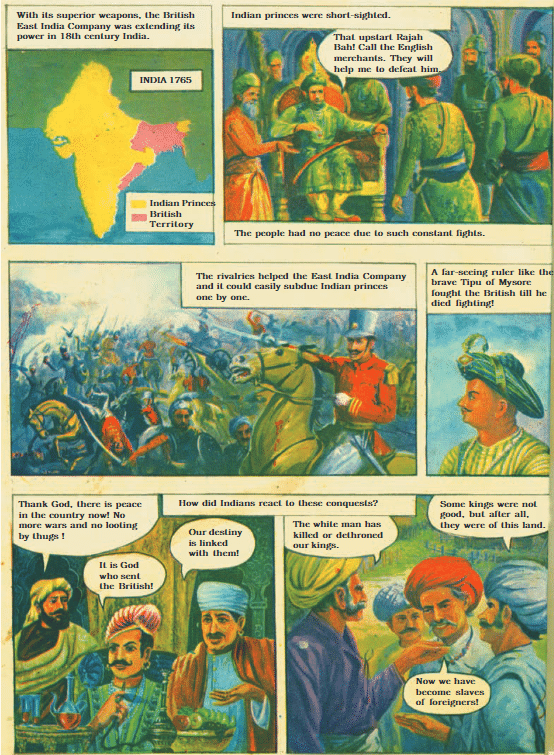
Ans. The East India Company expanded its control over India using its superior weapons, which included:
- Firearms: Advanced guns that outmatched local weaponry.
- Diplomacy: Strategic alliances and negotiations to weaken the opposition.
These tactics allowed the Company to conquer various regions and subdue Indian princes effectively.
Q3. Who is an artisan? Why do you think the artisans suffered? (Picture 3)
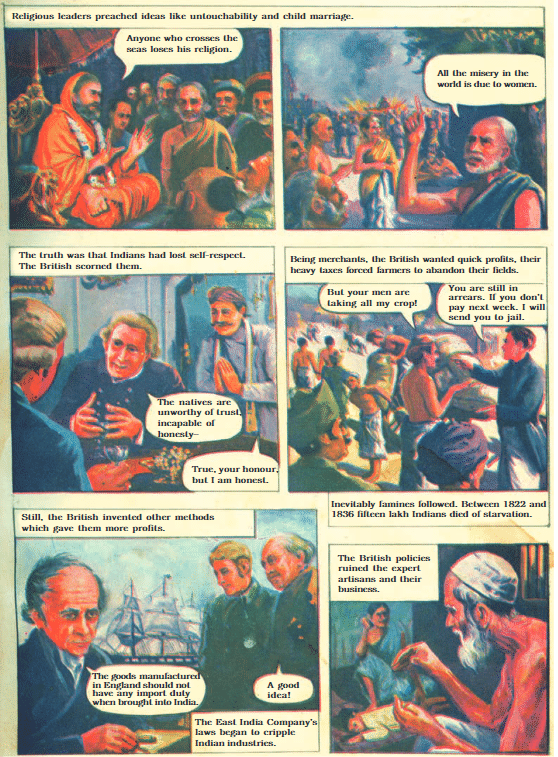
Ans. An artisan is a craftsman, skilled in some trade. They suffered because the goods that they produced lost demand in the Indian market.
Q4. Which picture, according to you, reveals the first sparks of the fire of revolt?
Ans. Picture 7 reveals the first spark of the fire of revolt.
Working with the Text (Page 45)
Answer the following questions.
Q1. Do you think the Indian princes were short-sighted in their approach to the events of 1757?
Ans. Yes, the Indian princes were short-sighted in their approach. They fought against each other with the help of the British. Thus the British became the virtual rulers.
Q2. How did the East India Company subdue the Indian Princes?
Ans. The East India Company spread their wings in India to promote their trade. They supported one Indian Prince to finish the other. As a result, power is passed onto their hands.
Q3. Quote the words used by Ram Mohan Roy to say that every religion teaches the same principles.
Ans. The words of Ram Mohan Roy spoken to his wife were: “Cows are of different colors, but the colour of their milk is the same. Different teachers have different opinions but the essence of every religion is the same.”
Q4. In what ways did the British officers exploit Indians?
Ans. The British rulers passed a resolution under which an Indian could be sent to jail without trial in a court. The goods manufactured in England were exempted from custom duty. The officers prospered on the company’s loot and their private business flourished.
Q5. Name these people.
(i) The ruler who fought pitched battles against the British and died fighting.
Ans. Tipu Sultan of Mysore.
(ii) The person who wanted to reform the society.
Ans. Raja Ram Mohan Roy of Bengal.
(iii) The person who recommended the introduction of English education in India.
Ans. Lord Macaulay
(iv) Two popular leaders who led the revolt (choices may vary.)
Ans. Nana Sahib Peshwa, Kunwar Singh, Begum Hazrat Mahal.
Q6. Mention the following.
(i) Two examples of social practices prevailing then.
Ans. Untouchability and child marriage.
(ii) Two oppressive policies of the British.
Ans. The British masters allowed imports in India tax-free. They ruined Indian cottage industries
(iii) Two ways in which common people suffered.
Ans. The farmers were taxed heavily and the thumbs of skilled workers were cut.
(iv) Four reasons for the discontent that led to the 1857 War of Independence.
Ans. (a) Santhals who lost their land became desperate and they revolted.
(b) Sepoys in the English army were angry due to lower pay than white soldiers.
(c) Brahmins were outraged upon learning the bullets contained cow and pig fat.
(d) Landlords were upset as British policies took away their land and estates.
Working with Language (Page 45)
In comics what the characters speak is put in bubbles. This is direct narration. When we report what the characters speak, we use the method of indirect narration. Study these examples.
First farmer: Why are your men taking away the entire crop?
Second farmer: Your men have taken away everything.
Officer: You are still in arrears. If you don’t pay tax next week, I’ll send you to jail.
- The first farmer asked the officer why his men were taking away the entire crop.
- The second farmer said that their men had taken away everything.
- The officer replied that they were still in arrears and warned them that if they did not pay tax the following week, he (the officer) would send them (the farmers) to jail.
1. Change the following sentences into indirect speech.
(i) First man: We must educate our brothers.
Second man: And try to improve their material conditions.
Third man: For that we must convey our grievances to the British Parliament.
The first man said that ___________a____________
The second man added that ____b___________
The third man suggested that_______c___________
Ans. (a) they must educate their brothers.
(b) should try to improve their material conditions.
(c) they must convey their grievances to the British Parliament.
(ii) First soldier: The white soldier gets huge pay, mansions, and servants.
Second soldier: We get a pittance and slow promotions.
Third soldier: Who are the British to abolish our customs?
The first soldier said that _________a________________
The second soldier remarked that ______b____________
The third soldier asked ____________c____________
Ans. (a) the white soldier got huge pay, mansions, and servants.
(b) they got a pittance and slow promotions.
(c) who the British were to abolish their customs.
Speaking and Writing (Page 46)
Q1. Play and act the role of farmers who have grievances against the policies of the government. Rewrite their speech bubbles in dialogue form first.
Ans.
Farmer 1:
“The government’s new policies are only benefiting the landlords and not us, the farmers. We are struggling to make ends meet. The taxes are too high, and we barely get any profit from our crops!”
Farmer 2:
“Yes! They are imposing heavy taxes on us, and we are being forced to sell our produce at low prices. We work hard, but our efforts don’t seem to matter.”
Farmer 3:
“The policies are making life difficult for us. We don’t even own the land we work on. We are treated like slaves, bound to work for others, with little or no freedom.”
Farmer 4:
“Our voices aren’t being heard. The government doesn’t understand our pain. We are in debt, struggling to feed our families while the rich grow richer.”
Farmer 5:
“Something needs to change. We must unite and demand justice. The government needs to see the reality of what we’re going through.”
The given dialogues are for reference. One can make their own also by following this pattern.
Q2. Look at the pictures.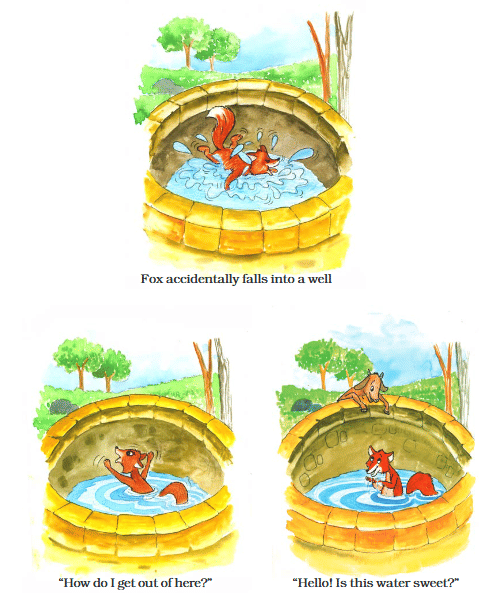
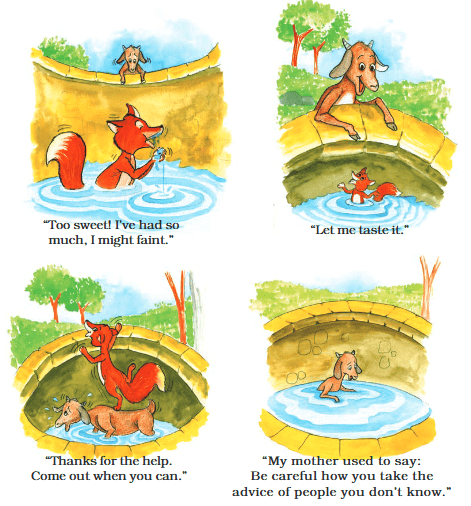
(i) Ask one another questions about the pictures.
- Where is the fox?
- How did it happen?
- What is the fox thinking?
- Who is the visitor?
- What does she want to know?
- What is the fox’s reply?
- What happens next?
- Where is the goat?
- Where is the fox now?
- What is the goat thinking?
Ans.
- The fox is in the well.
- She fell into the well by accident.
- The fox thinks about how to get out of there.
- The visitor is a goat.
- She wants to know whether the water is sweet.
- The fox replies that the water is very sweet and she had a lot of it.
- The goat wanted to taste the water.
- The goat is dragged into the water by the fox.
- The fox comes out of the well.
- The goat is thinking of her mother's advice not to trust any stranger.
(ii) Write the story in your own words. Give it a title
Ans. Title: The Fox and the Goat
Once, a fox fell into a well by accident and was trying to figure out how to escape. A goat happened to pass by, saw the well, and asked if the water was sweet. The clever fox lied, saying the water was the sweetest she'd ever tasted and invited the goat to try it. Eager to taste the water, the goat jumped in, and the fox used her back to climb out of the well. After thanking the goat for her help, the fox walked away, leaving the goat trapped inside. The goat then remembered her mother’s advice to never trust strangers.
Q3. Read the following news item. 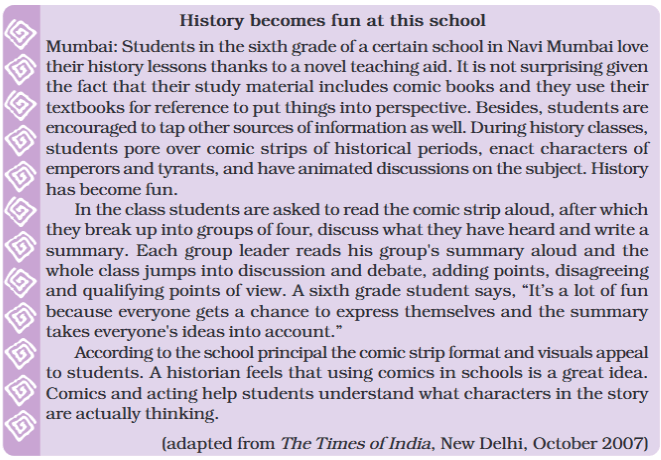 Based on this news item write a paragraph on what you think about this new method of teaching history.
Based on this news item write a paragraph on what you think about this new method of teaching history.
Ans. The innovative use of comic strips and interactive methods in teaching history, as practiced by the school in Navi Mumbai, is a refreshing approach to education. By incorporating comic books, role-playing, and group discussions, this method makes history lessons more engaging and fun for students. It enables them to visualize historical events and characters vividly, fostering a deeper understanding of the subject. Group activities such as summarizing and debating ideas help develop critical thinking and communication skills. This approach also makes learning collaborative, ensuring that every student’s voice is heard. Overall, it not only brings history to life but also makes the learning process more dynamic and enjoyable. Such methods should be encouraged in schools as they cater to varied learning styles and stimulate curiosity about the past.
Q4. Find the chapters in your history book that correspond to the episodes and events described in this comic. Note how the information contained in a few chapters of history has been condensed to a few pages with the help of pictures and ‘speech bubbles’.
Ans. In your history book, such episodes and events could correspond to chapters discussing significant historical periods, such as
Chapter 2: From Trade to Territory
- This chapter covers the rise of British power in India, focusing on events such as the Battle of Plassey and the consolidation of British rule. The enactment of characters like emperors or colonial administrators in the comic strip might relate to this.
Chapter 5: When People Revolt (1857 and After)
- This chapter highlights the Revolt of 1857, the struggles of soldiers, and the reactions of rulers and common people. The comic could depict episodes of rebellion or tyranny, simplifying the narrative through visuals.
Chapter 6: Colonialism and the City
- Changes in Indian cities during colonial rule, like the transformation of Delhi, can be creatively represented in comics to illustrate urban history and imperial policies.
Using comic strips condenses these chapters into concise, visually engaging formats, highlighting key events, characters, and discussions in a way that makes historical concepts easier to grasp and remember.
Q5. Create a comic of your own using this story.
Once the Sun and the Wind began to quarrel, each one saying that he was stronger than the other. At last they decided to test each other’s strength. A man with a cloak around his shoulders was passing by. The Wind boasted, “Using my strength I can make that man take off the cloak.” The Sun agreed. The Wind blew hard. The man felt so cold that he clasped his cloak round his body as tightly as possible.
Now it was the turn of the Sun which shone very hot indeed. The man felt so hot that he at once removed the cloak from his body. Seeing the man taking off the cloak, the Wind conceded defeat.
Ans. Title: The Sun and the Wind's Challenge
Panel 1:The Sun and the Wind are facing each other with angry expressions.
Wind: “I’m stronger than you, Sun!”
Sun: “Oh really? Let’s see who is stronger.”
Panel 2:They look at a man walking by, wearing a cloak. The Wind points at him with a smug smile.
Wind: “I can make that man take off his cloak with just one blow of my power!”
Panel 3:The Wind blows hard, making the man shiver. The man pulls his cloak tighter around his body.
Man: “Brrr! It’s too cold!”
Panel 4:The Sun beams down brightly with a cheerful smile.
Sun: “Now, let me show you how it's done.”
Panel 5:The Sun shines brightly and the man begins to sweat. He takes off his cloak, looking much more comfortable.
Man: “It’s so hot! I’ll take this off.”
Panel 6:The Wind looks defeated, puffing out air in frustration, while the Sun beams happily.
Wind: “You win, Sun. You’re the stronger one.”
Sun: “Sometimes, warmth is stronger than force.”
The given dialogues are for reference. One can make their own also by following this pattern.
|
36 videos|353 docs|56 tests
|
FAQs on Class 8 English Honeydew Chapter 3 Question Answers - Glimpses of the Past
| 1. What are the main themes discussed in "Glimpses of the Past"? |  |
| 2. How does the article portray the impact of British rule on India? |  |
| 3. What significant events are highlighted in "Glimpses of the Past"? |  |
| 4. How does the text encourage students to connect with history? |  |
| 5. What skills does the article aim to develop in students through its content? |  |
















